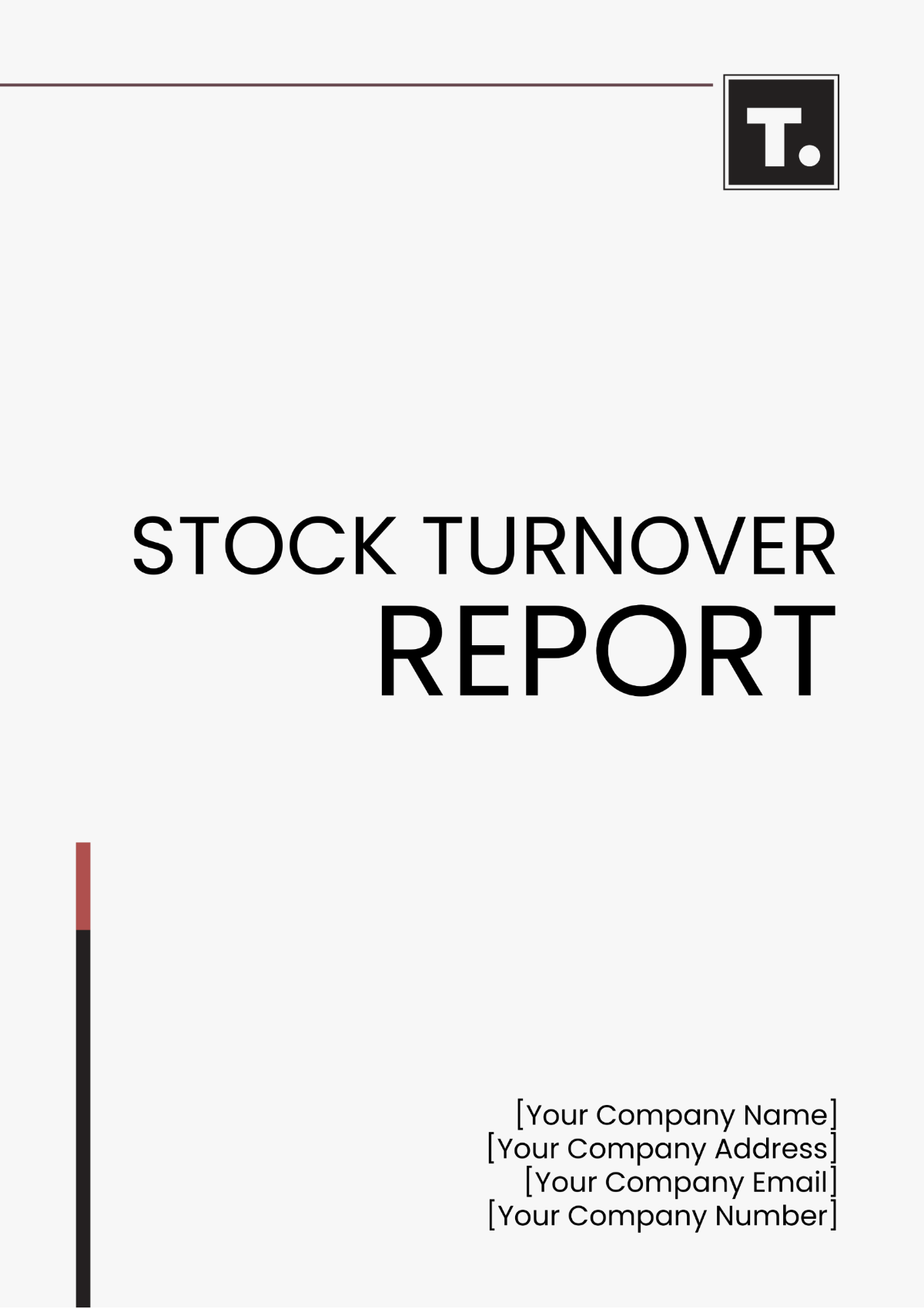Grocery Store Stock Report
Date: January 15, 2050
Prepared by: [Your Name]
Store Location: [Your Company Address]
Report Period: January 1, 2050 - January 15, 2050
I. Introduction
A. Purpose of the Stock Report
The purpose of this grocery store stock report is to provide a comprehensive overview of the current inventory status at [Your Company Name]. This report will help management make informed decisions regarding stock levels, ordering processes, and overall inventory management. Accurate stock reports are essential for maintaining optimal inventory levels, minimizing waste, and ensuring product availability for customers. Furthermore, this report aims to identify trends and patterns in stock movements, helping the store anticipate future demand more accurately. Effective inventory management is crucial for maximizing profitability and enhancing customer satisfaction.
B. Scope of the Report
This report covers the inventory data from January 1, 2050 to January 15, 2050. It includes detailed information on stock levels, product categories, supplier performance, and recommendations for future stock management. The report is divided into several sections, each addressing a specific aspect of inventory management. By providing an in-depth analysis of these areas, the report aims to give a clear picture of the current state of the store's inventory and identify areas for improvement. This comprehensive approach ensures that all critical factors affecting inventory are considered.
II. Stock Overview
A. Total Inventory Value
The total inventory value for the reporting period is $250,000. This figure represents the combined value of all products currently in stock at [Your Company Name]. It is important to monitor the total inventory value to ensure that the store is not overstocked or understocked, both of which can impact profitability. Overstocking can lead to increased storage costs and potential wastage, especially for perishable goods, while understocking can result in lost sales and customer dissatisfaction. Regular assessment of the total inventory value helps maintain a balance that supports efficient store operations and financial health.
B. Stock by Category
Fresh Produce
Total Stock Value: $50,000
Current stock levels for fresh produce include a variety of fruits, vegetables, and herbs. This category requires frequent restocking due to the perishable nature of the products. Fresh produce is a high-turnover category, reflecting customer demand for healthy, fresh food options. Seasonal variations also affect stock levels, necessitating careful planning to align with peak harvest times and promotional activities.
Dairy Products
Total Stock Value: $40,000
This category includes milk, cheese, yogurt, and other dairy products. Regular monitoring of expiration dates is crucial to minimize waste. Dairy products have a relatively short shelf life and require strict temperature control to maintain quality. Ensuring that the stock is rotated efficiently can help reduce losses due to spoilage. Consumer trends towards organic and specialty dairy products also influence stock management in this category.
Meat and Seafood
Total Stock Value: $60,000
Includes fresh and frozen meat and seafood items. Proper storage and handling are essential to maintain quality and safety. This category is critical for attracting customers seeking high-quality protein sources. Attention to sourcing practices, such as ensuring sustainable and ethical suppliers, can enhance the store's reputation. The high value of these products necessitates diligent inventory tracking to prevent theft and loss.
Pantry Staples
Total Stock Value: $70,000
This category covers dry goods such as grains, canned foods, and baking supplies. These items generally have a longer shelf life. Pantry staples are fundamental to household shopping and tend to have steady, predictable demand. Bulk purchasing opportunities can reduce costs, but it is essential to manage storage space effectively to avoid congestion. Regular promotions can help move large volumes and maintain fresh stock
Beverages
Total Stock Value: $30,000
Includes a variety of non-alcoholic and alcoholic beverages. Stock levels should be adjusted based on seasonal demand and promotions. Beverage sales can fluctuate significantly with weather changes, holidays, and special events. Stocking a diverse range of beverages can cater to different customer preferences, from everyday essentials to premium options. Effective merchandising and display strategies can boost sales in this category.
C. Stock by Supplier
Supplier A
Total Stock Supplied: $80,000
Supplier A provides a range of fresh produce and dairy products. They have consistently met delivery schedules and quality standards. A strong relationship with Supplier A ensures a steady supply of high-quality products, which is crucial for maintaining customer satisfaction. Regular communication and feedback help to address any issues promptly and improve service levels.
Supplier B
Total Stock Supplied: $90,000
Specializes in meat and seafood. Supplier B has a strong reputation for quality but has occasionally faced delays in delivery. Working closely with Supplier B to understand their logistical challenges can help mitigate delivery issues. Establishing clear expectations and contingency plans can ensure that stock levels remain stable despite occasional disruptions.
Supplier C
Total Stock Supplied: $80,000
Provides pantry staples and beverages. They offer competitive prices and reliable service. Supplier C's ability to deliver cost-effective products reliably supports the store's pricing strategy and profitability. Evaluating their performance regularly ensures that the store continues to benefit from their strengths while addressing any weaknesses.
III. Stock Level Analysis
A. Current Stock Levels
Current stock levels indicate the quantity of each product category available in the store. As of January 15, 2050, the following are the stock levels:
Fresh Produce
Apples: 300 units
Bananas: 200 units
Carrots: 150 units
Apples are a popular fruit with consistent demand. Maintaining adequate stock levels ensures availability for customers at all times. Bananas, being a staple in many households, also require regular replenishment to avoid stockouts. Carrots, used in a variety of dishes, need to be stocked adequately to meet customer needs.
Dairy Products
Milk: 400 units
Cheese: 250 units
Yogurt: 300 units
Milk is a daily essential for many customers, necessitating high stock levels to avoid shortages. Cheese, available in various types, attracts a diverse customer base, making it important to offer a wide selection. Yogurt's popularity as a healthy snack and breakfast option drives the need for consistent availability.
Meat and Seafood
Chicken: 500 units
Beef: 400 units
Salmon: 200 units
Chicken is a versatile and widely consumed protein, making it essential to keep ample stock. Beef, often used in various cuisines, requires careful stock management to cater to different preferences and cuts. Salmon, popular for its health benefits, should be stocked adequately to meet demand.
Pantry Staples
Rice: 600 units
Pasta: 500 units
Canned Beans: 700 units
Rice is a fundamental ingredient in many households, necessitating high stock levels. Pasta, available in different shapes and varieties, caters to a wide customer base. Canned beans, with their long shelf life, are a convenient and nutritious option, driving steady demand.
Beverages
Soda: 800 units
Juice: 600 units
Wine: 300 units
Soda is a popular choice for many customers, particularly during promotions and special events. Juice, available in various flavors, appeals to health-conscious customers and families. Wine, although a high-value item, requires careful stock management to align with customer preferences and seasonal trends.
B. Stock Turnover Rates
Stock turnover rates measure how quickly inventory is sold and replaced within the reporting period. Higher turnover rates indicate efficient stock management and high demand for products.
Fresh Produce
Turnover Rate: 1.5 times per month
The turnover rate for fresh produce reflects the high demand and perishable nature of these items. Efficient turnover ensures that the produce remains fresh and appealing to customers. Regular monitoring of stock levels and quick replenishment is essential to maintain this rate.
Dairy Products
Turnover Rate: 1.2 times per month
Dairy products have a moderate turnover rate, indicating steady demand. Regular rotation of stock and monitoring of expiration dates help maintain product quality and minimize waste. Promotional activities can boost turnover and attract more customers.
Meat and Seafood
Turnover Rate: 1.8 times per month
The high turnover rate for meat and seafood indicates strong customer demand. Ensuring proper storage and handling practices helps maintain product quality and safety. Regular communication with suppliers ensures timely delivery and replenishment of stock.
Pantry Staples
Turnover Rate: 1.0 times per month
Pantry staples have a steady turnover rate, reflecting their essential role in household shopping. Bulk purchasing and promotional offers can help move larger volumes and maintain fresh stock. Efficient stock rotation and storage practices are crucial to prevent overstock and wastage.
Beverages
Turnover Rate: 0.9 times per month
The turnover rate for beverages is slightly lower, indicating the need for targeted promotions and seasonal adjustments. Stocking a diverse range of beverages can cater to different customer preferences and boost sales. Effective merchandising and display strategies can enhance visibility and attract customers.
C. Stock Shortages and Overstock
Identifying stock shortages and overstock situations is critical for effective inventory management.
Shortages
Fresh Produce: Apples and carrots have experienced stockouts due to higher-than-expected demand. These shortages can disrupt sales and affect customer satisfaction, particularly if these items are popular or used in many recipes. Quick adjustments to ordering quantities and vendor negotiations may help address these issues. Implementing better forecasting methods and monitoring sales trends can also help anticipate future demand and prevent similar shortages.
Dairy Products: Yogurt has had frequent shortages, indicating a need to increase order quantities. Dairy products with short shelf lives can become a challenge to manage, requiring precise stock control and frequent replenishment. Expanding supplier options or increasing order frequency might help mitigate these shortages. Monitoring sales patterns and customer preferences can provide insights into optimal stock levels.
Overstock
Pantry Staples: Excessive stock of rice and pasta has led to storage issues. Overstock situations can cause clutter, increase storage costs, and tie up capital that could be used elsewhere. To manage overstock, consider implementing promotions or discounts to clear excess inventory. Adjusting future orders based on current stock levels and sales trends can help prevent recurrence of overstock issues.
Beverages: Overstock of soda and wine due to low seasonal demand. Managing beverage stock levels requires aligning with seasonal trends and promotions. Implementing targeted marketing strategies and adjusting order quantities based on historical data can help balance inventory. Additionally, exploring options for flexible ordering and supplier agreements may provide more responsive stock management.
IV. Supplier Performance
A. Delivery Timeliness
Evaluating supplier performance based on delivery timeliness helps ensure that the store receives products as scheduled. Timely deliveries are crucial for maintaining stock levels and meeting customer expectations. Delays can result in stockouts and disruptions to store operations, affecting overall customer satisfaction.
Supplier A
On-time Delivery Rate: 95%
Supplier A has consistently met delivery deadlines, contributing to reliable stock levels for fresh produce and dairy products. Their high on-time delivery rate indicates strong logistical capabilities and effective communication. Regular reviews of their performance and feedback sessions can further enhance their service and address any potential issues.
Supplier B
On-time Delivery Rate: 85%
Supplier B has faced occasional delays, particularly during peak demand periods. While their product quality is high, delivery delays have impacted stock levels for meat and seafood. Working with Supplier B to address their logistical challenges and exploring alternative solutions, such as backup suppliers or adjusted delivery schedules, can help mitigate these issues.
Supplier C
On-time Delivery Rate: 90%
Supplier C has generally met delivery schedules, although there have been minor delays with certain pantry staples. Maintaining regular communication with Supplier C can help address these minor issues and ensure consistent stock levels. Evaluating their performance periodically and discussing improvements can contribute to a more reliable supply chain.
B. Product Quality
Assessing product quality from suppliers is essential to maintain customer satisfaction and reduce waste. High-quality products contribute to a positive shopping experience and encourage repeat business. Regular quality assessments and feedback help ensure that suppliers meet the store's standards.
Supplier A
Quality Rating: 4.8/5
Supplier A provides high-quality fresh produce and dairy products, with minimal spoilage reported. Their commitment to quality is evident in the freshness and reliability of their products. Maintaining strong relationships with Supplier A and addressing any quality concerns promptly can help sustain high standards.
Supplier B
Quality Rating: 4.5/5
Supplier B's meat and seafood products are of high quality, though occasional issues with freshness have been noted. Ensuring proper handling and storage of these items can help minimize quality issues. Regular feedback and collaboration with Supplier B can help improve their quality and address any concerns.
Supplier C
Quality Rating: 4.7/5
Supplier C's pantry staples and beverages consistently meet quality standards. Their products are reliable and meet customer expectations, contributing to overall satisfaction. Regular evaluations and open communication with Supplier C can help maintain and enhance product quality.
C. Cost Analysis
Analyzing supplier costs helps optimize purchasing decisions and control expenses. Understanding cost structures and negotiating favorable terms can improve profitability and ensure competitive pricing for customers. Evaluating cost-effectiveness alongside quality and delivery performance is crucial for making informed decisions.
Supplier A
Average Cost per Unit: $1.20
Supplier A offers competitive pricing for fresh produce and dairy products. Their pricing aligns well with market rates, providing good value for the quality of products received. Periodic reviews of their pricing and cost structure can help identify opportunities for cost savings or better terms.
Supplier B
Average Cost per Unit: $2.50
Supplier B's meat and seafood products are priced higher due to quality and handling requirements. While their costs are higher, the quality of their products justifies the expense. Negotiating terms and exploring bulk purchasing options may help reduce costs while maintaining product quality.
Supplier C
Average Cost per Unit: $1.00
Supplier C provides cost-effective pantry staples and beverages, contributing to overall profitability. Their competitive pricing supports the store's pricing strategy and helps attract price-sensitive customers. Evaluating their cost structure regularly and considering alternative suppliers for further cost reductions can enhance financial performance.
V. Recommendations
A. Stock Level Adjustments
Based on the analysis, the following stock level adjustments are recommended to optimize inventory management and improve overall store operations.
Increase Order Quantities for High-Demand Items
Fresh Produce: Increase order quantities for apples and carrots to prevent stockouts and meet customer demand. Analyzing sales trends and customer preferences can help determine the appropriate increase in order quantities. Adjusting order schedules and collaborating with suppliers to ensure timely deliveries will support better stock management.
Dairy Products: Increase yogurt orders to address frequent shortages and align with customer preferences. Monitoring sales data and adjusting order quantities based on demand forecasts can help maintain adequate stock levels. Regular communication with suppliers can also help ensure a steady supply of yogurt.
Reduce Order Quantities for Low-Demand Items
Pantry Staples: Adjust rice and pasta orders to avoid overstock and free up storage space. Evaluating historical sales data and customer feedback can help determine optimal order quantities. Implementing inventory control measures and adjusting future orders based on current stock levels can help prevent overstock situations.
Beverages: Reduce soda and wine orders based on seasonal demand patterns and sales trends. Implementing promotional strategies and adjusting inventory levels in response to changing demand can help manage stock effectively. Monitoring sales data and adjusting orders accordingly will support better inventory management.
B. Supplier Management Strategies
Improving supplier relationships and performance is crucial for maintaining optimal stock levels and ensuring reliable supply.
Negotiate Better Terms
Work with Supplier B to negotiate better delivery schedules and cost terms for meat and seafood. Exploring options for volume discounts, flexible delivery arrangements, and improved payment terms can help enhance supplier agreements. Regular reviews and feedback sessions with Supplier B can contribute to better terms and improved service.
Explore Alternative Suppliers
Consider alternative suppliers for pantry staples to reduce costs and improve delivery reliability. Evaluating new suppliers based on their performance, pricing, and delivery capabilities can provide additional options for managing stock. Establishing relationships with multiple suppliers can offer greater flexibility and reduce dependency on a single source.
C. Inventory Management Practices
Implementing effective inventory management practices will help maintain balanced stock levels, reduce waste, and improve overall efficiency.
Regular Stock Audits
Conduct monthly stock audits to verify inventory levels and identify discrepancies. Regular audits help ensure accurate stock records, identify potential issues, and support better inventory control. Implementing standardized procedures for stock audits and training staff on best practices will enhance accuracy and efficiency.
Enhanced Forecasting Techniques
Utilize advanced forecasting techniques to predict demand patterns and adjust stock levels accordingly. Incorporating data analytics, historical sales data, and market trends can improve forecasting accuracy. Implementing forecasting tools and collaborating with suppliers to align on demand projections can enhance inventory management.
Training for Staff
Provide training for staff on proper stock handling, storage, and inventory management procedures. Well-trained staff contribute to better stock control, reduced waste, and improved customer service. Regular training sessions and updates on best practices will support effective inventory management and operational efficiency.
VI. Conclusion
A. Summary of Findings
The grocery store stock report for [Your Company Name] highlights several key findings. The total inventory value stands at $250,000, with fresh produce, dairy products, and meat and seafood being the primary categories. Supplier performance is generally satisfactory, though improvements in delivery timeliness and cost management are recommended. The analysis of stock levels, turnover rates, and shortages provides insights into current inventory management practices and areas for improvement. Implementing the recommendations outlined in this report will help optimize inventory levels, enhance supplier relationships, and improve overall store operations.
B. Action Items
The following action items are proposed based on the report's findings:
Adjust Stock Levels
Increase order quantities for high-demand items such as fresh produce and dairy products, and reduce orders for low-demand items like pantry staples and beverages. Implementing these adjustments will help maintain balanced inventory levels and meet customer demand more effectively.
Enhance Supplier Relations
Negotiate better terms with Supplier B and explore alternative suppliers for cost savings and improved delivery reliability. Strengthening supplier relationships and addressing performance issues will contribute to more efficient stock management and better service.
Implement Best Practices
Conduct regular stock audits, utilize advanced forecasting techniques, and provide staff training on inventory management. Adopting these best practices will support more accurate inventory control, reduce waste, and improve overall store efficiency.
C. Future Reporting
To ensure continuous improvement in inventory management, future reports will incorporate more detailed analysis of seasonal trends, customer preferences, and supplier performance metrics. Regular updates and reviews will help refine inventory management practices and address emerging challenges. Ongoing evaluation and adaptation of strategies will contribute to sustained success and operational excellence at [Your Company Name].















